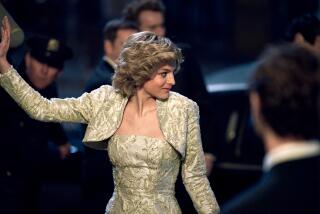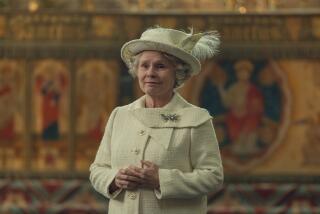A Tribute of Silence That Speaks Volumes
LONDON â After a week of shock, denial, anger and grief came the overwhelming silence.
As the closed casket of Diana, princess of Wales, wound slowly through central London on Saturday on a horse-drawn gun carriage, more than 1 million people bid farewell in the most respectful way they could: with a long, collective hush.
There were tears, of course, and murmured conversation. Later, during and after the memorial service at Westminster Abbey, there were even shouts and applause. But when it was over, what mourners remembered most about this cathartic day was their own haunting silence.
âEven the babies stopped crying,â said Neil McArthur, a pianist.
The quiet and restraint of the crowd, the largest in London since the end of World War II, enhanced the simplicity of Dianaâs three-mile procession in sunshine from Kensington Palace to the abbey.
âVery elegant, like she was,â Laurie Robinson said after the carriage had passed a few feet away. âNothing complicated. Nothing fussy. Very stark.â
Robinson, a 47-year-old Londoner, watched the procession from Constitution Hill, a leafy boulevard that runs through Green Park to Buckingham Palace. He arrived at 2 a.m., claimed a place along the police barrier and plunked down in a sleeping bag, one of dozens of campers lying end to end.
By 9:08 a.m., when Dianaâs carriage began its journey, the people at the metal barrier stood 10 deep. Behind them, later arrivals sprawled on the grass, reading newspaper supplements about Dianaâs life or following the cortegeâs progress by radio with earphones.
It seemed that everyone who wanted a glimpse of the coffin found some vantage point--thanks to Buckingham Palaceâs decision, in response to mass mourning for Diana, to make the route three times longer than planned.
âFor one day, at least, the nation has come together for this pilgrimage,â said Nila Farhad, a teacher. âThereâs no pushing, no shoving, no stupidity. Everyone is giving each other space.â
As the crowd in Green Park swelled, stewards from Wembley Stadium stood watch in orange vests, joining thousands of volunteers deployed to help keep order. Such was the crowdâs restraint that the stewards had little to do but hand out packets of tissue.
Three Peruvians hoisted a banner saluting Diana from their South American country--until a police officer reminded them politely: No signs today. A schoolgirl climbed a lamppost for a better view of the route; a steward asked her father to coax her down.
A few minutes later, a truck pulled up near Buckingham Palace to unload portable toilets.
âIn normal times the people and the traffic would have drowned out the sound of that lorryâs engine,â said Michael Ingram, 60. âI used to drive tour buses along Piccadilly and curse the traffic, but today [with the road closed] thereâs not a vehicle in sight. The sheer volume of people and the terrible quiet--it just takes your breath away.â
At 10:15 a.m., as the cortege approached Constitution Hill from Hyde Park Corner, a woman stood on a stool and began joking loudly with friends. Glares shot up at her, and she shut up.
For the next few seconds, the only sound came from the hoofs of the horses escorting the carriage.
Cameras and video recorders sprouted into the air, held as high as hands could reach. A bouquet of white carnations flew over the rail and struck Dianaâs casket. The procession passed Ginny and Clive Tinker in less than a minute.
âIt was so quiet and so quick--so lovely in its simplicity,â said Ginny Tinker, a surveyorâs secretary from Portsmouth in southern England. âUntil that moment, none of this seemed real.â
A few feet away, Megan Terrell, 25, an Australian nurse at a hospital in Romford, leaned over the rail in tears, watching the cortege recede past Buckingham Palace.
âWeâve been seeing photos of the living Diana all week,â she said. âThey say sheâs dead, but it isnât like sheâs really gone. Then you see the horses and that gun carriage and then you realize, oh my God, sheâs in that coffin. Sheâs really gone.â
Kevin Watkins, 21, had been watching the throngs from about 10 feet back, on duty for Crowd Recruiting PLC, a crowd-control company. When the horses approached, he turned his eyes away.
âI canât watch,â he said. âIt will only bring back the disastrous news of her death. I keep hoping this is a movie that will soon be over.â
As the procession passed, mourners drifted away from the railing in hushed twos and threes and walked to Hyde Park to watch the memorial service on two giant television screens.
Many sat on the rolling lawn or chatted quietly on the fringes of the growing crowd. But most people surged toward the screens.
Thousands of them wore black, but it was the kind of demotic black more often seen at rock concerts, shopping malls or nightclubs than at funerals--jeans, platform shoes, T-shirts and backpacks. One man in his 50s had dressed in the striped trousers, waistcoat and black silk top hat of Britainâs tradition of grief. But even he wore rakishly modern reflector sunglasses.
It was not a day for popular anger or for politics. Despite a week of furious criticism of the royal family, mourners rose spontaneously to their feet when the national anthem, âGod Save the Queen,â drifted out of the loudspeakers and the service began.
By then, the crowd in front of the screens was a quarter of a mile deep.
Tears reddened eyes when Dianaâs friend, singer Elton John, appeared on the screens to sing a new version of his song âCandle in the Wind.â There were more soundless tears during Prime Minister Tony Blairâs emotional Bible reading from 1 Corinthians, on the importance of love.
At the end of a fierce address by Dianaâs brother, Charles Spencer--an attack on royal stuffiness and media viciousness, and an affectionate remembrance of the princess--the silence dissolved into applause and cheers.
âThatâs what everyone was waiting for the queen to say all week, but she couldnât say it,â whispered Bronwyn McLaren, a 31-year-old Australian nurse.
âWell, he told âem,â yelled a middle-aged man in the crowd as the address ended. The comment drew applause.
But quiet returned to the park as, the service over, the coffin began its journey to Dianaâs family home for burial and Britain marked a formal minute of silence.
As they drifted away from the screens, Britons spoke quietly about lessons drawn from a week of mourning.
âThe royal family rejected her, the press people chased her, but we all wanted to know more about her,â said Labuda Sultana, 27, a trainee dentist from Bangladesh. âAnd now we should all feel sorry because weâre all a little bit guilty.â
âA lot of people are reflecting on themselves, looking at their own lives and how they relate to others,â said Martin Procter, 35, a Defense Ministry clerk.
Perhaps the most unpopular person in Hyde Park was Heiko Khoo of London, who carried a big sign inviting people to a debate today at Speakerâs Corner in the park on the future of the monarchy.
He was harassed repeatedly by mourners leaving the park.
âItâs improper to even think about this today,â said Kevin Wright, who agreed that the subject was worth debating at some point. âCanât you wait until the mourning is over?â
More to Read
Sign up for Essential California
The most important California stories and recommendations in your inbox every morning.
You may occasionally receive promotional content from the Los Angeles Times.










